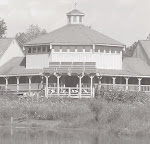The funny thing about invasive plants is that at some point they probably seemed like a good idea. Mid "native seed shopping" in the Riveredge shop, my eye was drawn to a glossy poster identifying beautiful flowers and I got closer to read what they were. You can imagine how disheartened I was when I realized the colorful flower photos were for identification of invasive species.
Culinary herb Garlic Mustard and magenta-flowered Purple Loosestrife probably received compliments on their ease and drought resistance before spreading throughout the county. They grew, they prospered, they took over!
But those flowers, those beautiful troublesome flowers are my downfall. There is something perverse about plucking a gorgeously petaled stem and tossing it into a trash can (note: not the compost). I am not alone in my sympathies, however! Years ago, a friend transplanted a thorny tree to the front of her yard to admire the pretty blossoms each spring. She couldn't believe her good luck that such a plant would "appear" in her yard until her inspiration was crushed by a horticulturist who identified the plant as a Buckthorn.
Until a anti-invasives support group is established to help myself and my fellow flower lovers, I've devised the following process to soften the ordeal.
Step 1: Observe your beautiful (insert flowery invasive plant here-mine is Dame's Rocket)
Step 2: Inhale the perfumed petals you'd willingly spend money for if you saw them at the florists
Step 3: Remember to bend and lift with your knees
Step 4: Then...RIP THEM OUT BY THE ROOT!
Step 5: Arrange in a vase for the biggest bouquet of your lifetime.
Step 6: Recover from shock with native wildflower retail therapy. With natives, you can forget the fertilizer, constant watering, and subconscious fear that in a few decades you'll discover your garden was a contributor of the next invasive crisis. Johnson's Nursery Menomonee Falls is having a (locally grown) native plant sale to benefit Wild Ones. Those not needing retail therapy are also invited. June 11, 8-6 and June 12, 10-6. I'll see you there!
Wednesday, June 8, 2011
Subscribe to:
Post Comments (Atom)








I don't get it, are you telling us to ENJOY THEM, Or RIP them OUT? I see no harm in leaving them alone and letting them go wild in the yard. They're not hurting anything except the pocket book of the nursery's. Right?
ReplyDeleteHi Annonymous,
ReplyDeleteThank you for your comment and you present a great question.
As beautiful as some invasive species are, they do not play well with other plants and, in answer to your question, are best enjoyed ripped out (the vase is optional).
Even though a single yard of invasive flowers may not seem threatening, the plants have an uncanny ability to spread and seeds can remain dormant in the soil for many years.
So how is a pretty little flower threatening?
Invasive plants are those that are so aggressive that they harm local ecosystems by hindering native species. Some species, like the Purple Loosestrife, overtake areas of marsh where diverse native species once grew. Buckthorn and Garlic Mustard damage woodlands by shading out vegetation. Buckthorn keeps young saplings from growing up and replacing the taller trees. On the smaller scale, Garlic Mustard shades out native flowers trillium, Jacob's ladder, and wild geranium.
Many of the now invasive plants started as ornamentals in gardens and escaped. The great thing about native plants is that they offer the beauty, shade, flowers and foliage interest needed for landscaping but don't threaten local flora. A plus for homeowners is that native plants require less maintenance, watering and fertilizer.
As for the nurseries; not all offer native plants. Johnson's Nursery is having their sale and we always carry a wide variety of seeds.
If anyone is aware of other sources I would love to hear about them.
Southeastern Wisconsin Invasive Species Consortium, Inc. (SEWISC) is a great resource on issues like this. Check out their website -
ReplyDeletehttp://www.ipaw.org/sewisc/